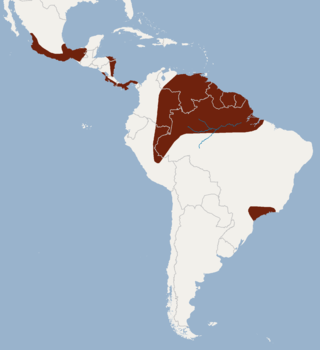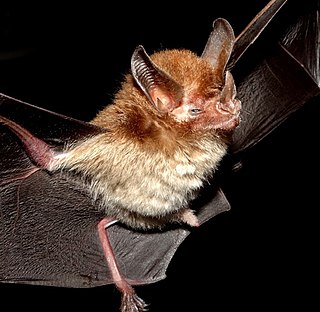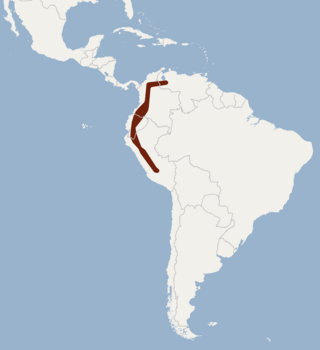
The chivi vireo is a small South American songbird in the family Vireonidae. It was formerly considered a subspecies of the red-eyed vireo. It is usually green to yellow-green in color with off-white underparts, and a gray crown. It has a whitish supercilium extending over its ear coverts, and its lores are dull gray in color. The chivi vireo has nine subspecies. It is found throughout most of northern, eastern and central South America, only being absent from southern Chile and southern Argentina. It inhabits multiple types of habitat across its range, and appears to adjust well to slightly disturbed habitat. The chivi vireo is mainly resident, but at least two of the subspecies inhabiting the south of its range are known to be migratory.

The Mato Grosso dog-faced bat, is a bat species found in South America. It is the only species in the genus Neoplatymops.

The big free-tailed bat is a bat species found in the Americas.

Miller's long-tongued bat is a bat species found in northern Brazil, Venezuela, Colombia, Guyana, Trinidad and Tobago, Grenada, the Netherlands Antilles and the U.S. Virgin Islands.

The tricolored big-eared bat is a bat species from South and Central America.

The dark long-tongued bat is a species of bat from South and Central America. It was formerly considered the only species within the genus Lichonycteris, but is now recognized as one of two species in that genus, along with the pale brown long-nosed bat. It is small species of bat, with adults weighing 6–11 g (0.21–0.39 oz) and having a total length of 46–63 mm (1.8–2.5 in).

The pygmy round-eared bat is a bat species from South and Central America.

Schmidts's big-eared bat is a bat species from South and Central America.

Sturnira known as a yellow-shouldered bat or American epauleted bat, is a genus of bat in the family Phyllostomidae. The genus name comes from the Latin for "starling" and refers to HMS Starling, which took part in an 1836 voyage to Brazil during which the type specimen was collected. It contains the following species:

The bidentate yellow-shouldered bat is a species of bat in the family Phyllostomidae. It is found in South America.

The Bogotá yellow-shouldered bat is a species of bat in the family Phyllostomidae. It is found in Colombia, Ecuador, Peru, and Venezuela at altitudes from 300 m to above 2000 m, particularly in cloud forest. The species is primarily frugivorous; it may also consume nectar and pollen.

The Talamancan yellow-shouldered bat is a species of bat in the family Phyllostomidae. It is found only in Costa Rica and Panama, and there are no subspecies.

The lesser yellow-shouldered bat is a species of bat in the family Phyllostomidae. It is native to Peru and Ecuador. It is threatened by habitat loss.

The Thomas's shaggy bat is a bat species from Central and South America. It was previously included in the shaggy bat but Simmons and Handley (1998) showed that the species were distinct.

Platyrrhinus ismaeli is a species of bat found in South America.
Sturnira perla is a species of yellow-shouldered bat found in Ecuador.
Burton's yellow-shouldered bat is a species of leaf-nosed bat found in Panama and Costa Rica.
Myotis diminutus is a species of mouse-eared bat found in Ecuador and Colombia. It was recently described as a new species in 2011.
Lonchophylla orienticollina is a species of bat found in Colombia, Venezuela, and Ecuador.

The little yellow-shouldered Mesoamerican bat is a species of leaf-nosed bat found in Mexico and Central America.

















